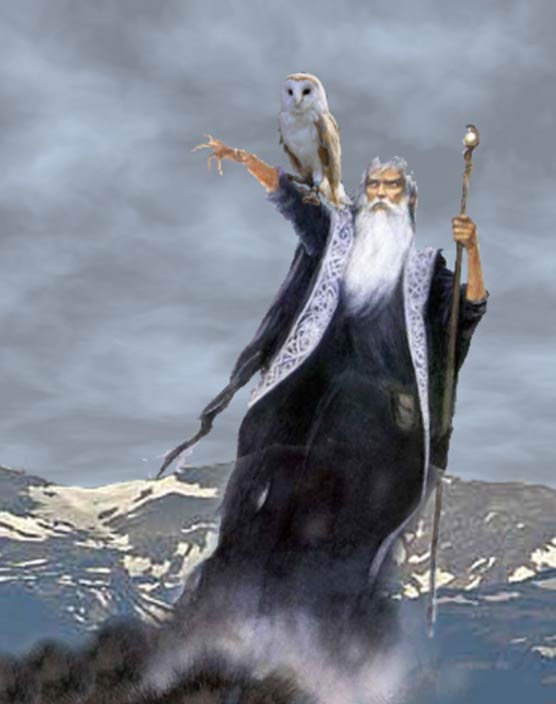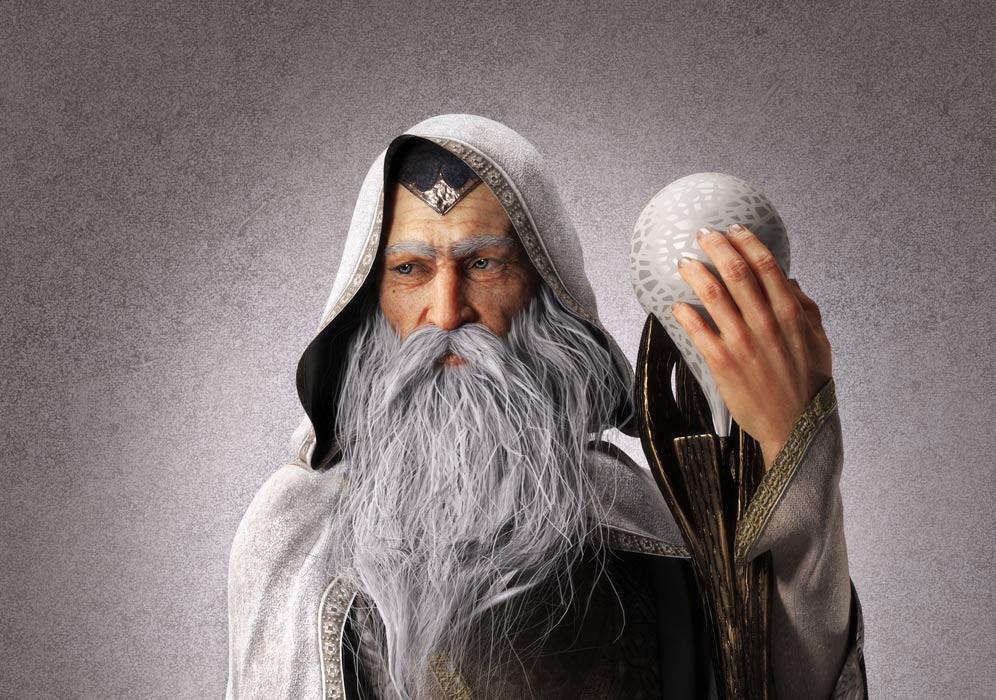The Legendary Origins of Merlin the Magician
Most people today have heard of Merlin the Magician, as his name has been popularized over the centuries and his story has been dramatized in numerous novels, films, and television programs. The powerful wizard is depicted with many magical powers, including the power of shapeshifting, and is well-known in mythology as a tutor and mentor to the legendary King Arthur, ultimately guiding him towards becoming the king of Camelot. While these general tales are well-known, Merlin’s initial appearances were only somewhat linked to Arthur. It took many decades of adaptations before Merlin became the wizard of Arthurian legend he is known as today.

Merlin the wizard. (Andy/CC BY ND 2.0)
Merlin and Ambrosius
It is common belief that Merlin was created as a figure for Arthurian legend. While Merlin the Wizard was a very prominent character in the stories of Camelot, that is not where he originated. Writer Geoffrey of Monmouth is credited with creating Merlin in his 1136 AD work, Historia Regum Britanniae – The History of Kings of Britain. While a large portion of Historia Regum Britanniae is a historical account of the former kings of Britain, Merlin was included as a fictional character (although it is likely that Geoffrey intended for readers to believe he was a figure extracted from long-lost ancient texts). Merlin was paradoxical, as he was both the son of the devil and the servant of God.
Merlin was created as a combination of several historical and legendary figures. Geoffrey combined stories of North Brythonic prophet and madman, Myrddin Wyllt, and Romano-British war leader, Ambrosius Aurelianus, to create Merlin Ambrosius. Ambrosius was a figure in Nennius' Historia Brittonum.
In Historia Brittonum, British king Vortigern wished to erect a tower, but each time he tried, it would collapse before completion. He was told that to prevent this, he would have to first sprinkle the ground beneath the tower with the blood of a child who was born without a father. Ambrosius was thought to have been born without a father, so he was brought before Vortigern.
Ambrosius explained to Vortigern that the tower could not be supported upon the foundation because two battling dragons lived beneath, representing the Saxons and the Britons. Ambrosius convinced Vortigern that the tower would only stand with Ambrosius as a leader, and Vortigern gave Ambrosius the tower, which was also the kingdom. Geoffrey retold this story with Merlin as the child born without a father, although he retained the character of Ambrosius.

Illumination of a 15th century manuscript of Historia Regum Britanniae showing king of the Britons Vortigern and Ambros waching the fight between two dragons. (Public Domain)
In Geoffrey’s version of the story, he included a long section containing Merlin’s prophecies, along with two other stories, which led to the inclusion of Merlin into Arthurian legend. These include the tale of Merlin creating Stonehenge as the burial location for Ambrosius, and the story of Uther Pendragon sneaking into Tintagel where he fathered Arthur with Igraine, his enemy’s wife.
This was the extent of Geoffrey’s tales of Merlin. Geoffrey does not include any stories of Merlin acting as a tutor to Arthur, which is how Merlin is most well-known today. Geoffery’s character of Merlin quickly became popular, particularly in Wales, and from there the tales were adapted, eventually leading to Merlin’s role as Arthur’s tutor.

A giant helps Merlin build Stonehenge. From a manuscript of the Roman de Brut by Wace. (Public Domain)
Merlin – The Poem
Many years after Geoffrey’s Historia Regum Britanniae, Robert de Boron composed a poem called Merlin. Boron’s Merlin has the same origins as Geoffrey’s creation, but Boron placed special emphasis on Merlin’s shapeshifting powers, connection to the Holy Grail, and his jokester personality. Boron also introduced Blaise, Merlin’s master.
Boron’s poem was eventually re-written in prose as Estoire de Merlin, which also places much focus upon Merlin’s shapeshifting. Over the years, Merlin was interspersed through the tales of Arthurian legend. Some writings placed much focus upon Merlin as Arthur’s mentor, while others did not mention Merlin at all. In some tales Merlin was viewed as an evil figure who did no good in his life, while in others he was viewed favorably as Arthur’s teacher and mentor.

Merlin reciting his poem in a 13th-century illustration for ‘Merlin’ by Robert de Boron (Public Domain)
Merlin’s Love and Death
Eventually, from the various tales emerged Merlin’s downfall, at the hands of Niviane (Vivien), the king of Northumberland’s daughter. Arthur convinces Niviane to stay in his castle, under Merlin’s encouragement. Merlin falls in love with Niviane. However, Niviane fears Merlin will use his magical powers to take advantage of her. She swears that she will never fall in love with him, unless he teaches her all of the magic he knows. Merlin agrees.
Merlin and Niviane depart to return to Northumberland, when they are called back to assist King Arthur. As they are returning, they stop to stay in a stone chamber, where two lovers once died and were buried together. When Merlin falls asleep, Niviane places him under a spell, and traps him within the stone tomb, where he dies. Merlin had never realized that his desire for Niviane, and his willingness to teach her his magical ways eventually led to his untimely death.

Merlin and Vivien. (Archivist /Adobe Stock)
Merlin the Wizard’s Legacy
In 2019, fragments of a rare manuscript published in the 1500s were found in the University of Bristol's special collections library detailing “subtle but significant differences from the traditional story” of Merlin the magician. For example, the deaths of some characters in the stories are different from more traditional accounts and there are more detailed descriptions of key events such as battles.
- Merlin: Warrior & Poet. Two Historical Figures that Inspired the Legend
- The Magical Message of Merlin Versus Modern Materialism
- Fragments of Ancient Manuscript About Merlin Have Been Discovered and Could Change Arthurian Legend
These variations in the stories of Merlin are not too surprising because from Merlin’s inception through the writings of Geoffrey, the wizard appeared in different forms through many subsequent tales, stories, and poems. Today, Merlin is most well-known for being the wizard who tutored and taught the young Arthur, before he grew to become the King of Camelot. It was under Merlin’s counsel that Arthur became the king that he was.
While this legend continues on today, it is interesting to see the many variations of Merlin, from an evil wizard, to a shapeshifter, to one who met his downfall from teaching his powers to the woman he loved. This formidable and versatile character caught the attention of many people centuries ago, and continues to play a prominent role in today’s storytelling.
Top Image: Representation of Merlin the magician. Source: storm /Adobe Stock
By M R Reese
Updated on June 5, 2020.
References:
The True History of Merlin the Magician – The Guardian. Available from: http://www.theguardian.com/books/2013/dec/11/true-history-merlin-anne-lawrence-mathers-review
Merlin the Magician – King Arthur & the Knights of the Roundtable. Available from: http://www.kingarthursknights.com/others/merlin.asp
The Many Faces of Merlin – Timeless Myths. Available from: http://www.timelessmyths.com/arthurian/merlin.html
Merlin – The Camelot Project. Available from: http://d.lib.rochester.edu/camelot/theme/merlin


















Comments
Think about it. A white wandering celestial body which mysteriously appears and disappears in the night sky. Streaking and disturbing the “Gods” or “stars” with its omnipitent presence. Its long white tail trails the sky like merlins long white beard. Guiding star gazers that the cosmos wants the next newborn to become “king”. Sounds like another stupid Jesus story or Israelite story to me
Think about it. A white wandering celestial body which mysteriously appears and disappears in the night sky. Streaking and disturbing the “Gods” or “stars” with its omnipitent presence. Its long white tail trails the sky like merlins long white beard. Guiding star gazers that the cosmos wants the next newborn to become “king”. Sounds like another stupid Jesus story or Israelite story to me
Merlin the Magician:
Merlin was a Nephilim. His father was a demon (tetraploid human/incubus) while his mother was presumably a witch (diploid human).
The breeding of a tetraploid with a diploid results in a sterile triploid. They are much bigger, stronger and smarter than diploids but lesser than that of tetraploid genetics.
This explains why Merlin was so intelligent and continues to be a legend to this day. His academic work was superlative and far beyond the people of the day, with the exception of the Serpent People (tetraploid humans).
William H. Bradhaw, Dipl. T, CPIM
http://SecretsPinkKush.ZapperSoftware.com
You really have got it all wrong about the origins of Merlin. The sword in the stone is an ancient story from Tuscany in Italy. the sword is still in the stone there at Montesiepi, the knight was Sir Galgano Chuidotti. The story was taken to England. However the real surprise is on the town register at the village of Chuidotti Galgano's birth place a few minutes away. There you will find recorded the name 'Merlini' a friend of the knight.
thanks Ron Ritter
Do you remember where you learned that? I'd very much like to know if possible :)
Pages